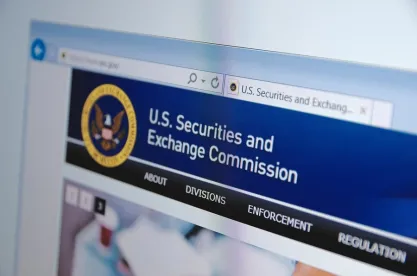For many U.S. public companies, June 30 is the end of their second fiscal quarter, which means it’s time to evaluate their filer status, with any changes taking effect as of the next fiscal year. Here are a few things to remember, including the impact of the SEC’s recent amendments to the “accelerated filer” and “large accelerated filer” definitions that became effective in April 2020. The amendments exclude certain smaller reporting companies (“SRC”) from these categories of issuers, exempting them from the requirement to provide an auditor attestation of internal control over financial reporting (“ICFR”) under Sarbanes-Oxley Act Section 404(b) and providing them with extended SEC filing deadlines.[1]
Determination of Initial Filer Status
Companies with December 31 year ends are required to calculate their public float as of June 30 (the last business day of its most recently completed second fiscal quarter) to determine their SEC filer status for the next fiscal year.[2] Based on the public float calculation, a new SRC revenue test and other requirements, a company can initially qualify as a:
-
Large Accelerated Filer – a public float of $700 million or more and is not an SRC under the SRC revenue test referenced below;[3]
-
Accelerated Filer – a public float of $75 million or more, but less than $700 million and is not an SRC under the SRC revenue test referenced below;[4] or
-
Non-Accelerated Filer – a public float of less than $75 million, is an SRC under the SRC revenue test referenced below or does not otherwise meet the requirements of a large accelerated filer or an accelerated filer.
In addition to the categories of filers above, a December 31 year-end company can also initially qualify as an SRC if at June 30 it has (1) a public float of less than $250 million or (2) annual revenues of less than $100 million for its most recently completed fiscal year for which audited financial statements are available and either (a) no public float or (b) a public float of less than $700 million. A company that is an SRC may take advantage of certain less stringent scaled disclosure requirements if it chooses to do so. In addition, under the new amendments to the large accelerated filer and accelerated filer definitions an SRC pursuant to the revenue test referenced in clause 2 above qualifies as a non-accelerated filer and does not have to provide a separate attestation of its ICFR from its outside auditors.
The following table provides a summary of the initial filer alternatives as well as whether the company is required to obtain a separate attestation of its ICFR from outside auditors and its future SEC filing deadlines:
|
Status |
Public Float |
Annual Revenues |
Auditor Attestation Requirement* |
Filing Deadlines |
|
Large Accelerated Filer (not SRC) |
$700 million or more |
N/A |
Yes |
Annual Report (60 days after fiscal year end) Quarterly Report (40 days after fiscal quarter end) |
|
Accelerated Filer (not SRC) |
$250 million to less than $700 million |
$100 million or more |
Yes |
Annual Report (75 days after fiscal year end) Quarterly Report (40 days after fiscal quarter end) |
|
SRC and Accelerated Filer |
$75 million to less than $250 million |
$100 million or more |
Yes |
Annual Report (75 days after fiscal year end) Quarterly Report (40 days after fiscal quarter end) |
|
SRC and Non-Accelerated Filer |
$75 million to less than $700 million |
Less than $100 million |
No |
Annual Report (90 days after fiscal year end) Quarterly Report (45 days after fiscal quarter end) |
|
Less than $75 million |
N/A |
No |
Annual Report (90 days after fiscal year end) Quarterly Report (45 days after fiscal quarter end) |
* Under the Jumpstart Our Business Startups Act (known as the JOBS Act), emerging growth companies (a company generally qualifies as an emerging growth company until the earlier of (1) the last day of the fiscal year ending after the fifth anniversary of its initial public offering; (2) the last day of the fiscal year in which its total annual gross revenues are $1.07 billion or more; or (3) the date that it becomes a large accelerated filer) are already exempt from the auditor attestation requirement.
Entering and Exiting Filer Status after Initial Determination
If a company has already made its initial determination of its filer status, it will remain that category of issuer until at a future determination date (i.e., a subsequent June 30) it meets the thresholds set forth in the following table:
|
Initial Filer Status |
Subsequent Public Float |
Resulting Filer Status |
|
Large Accelerated Filer |
$560 million or more |
Large Accelerated Filer |
|
Less than $560 million, but $60 million or more |
Accelerated Filer |
|
|
Less than $60 million |
Non-Accelerated Filer |
|
|
Accelerated Filer |
$700 million or more |
Large Accelerated Filer |
|
Less than $700 million, but more than $60 million |
Accelerated Filer |
|
|
Less than $60 million |
Non-Accelerated Filer |
|
|
Non-Accelerated Filer |
$700 million or more |
Large Accelerated Filer |
|
Less than $700 million, but more than $75 million |
Accelerated Filer |
|
|
Less than $75 million |
Non-Accelerated Filer |
In addition to these public float thresholds, the recent amendments also added the SRC revenue tests to the large accelerated filer and accelerated filer transition rules. As a result, a large accelerated filer or an accelerated filer also transitions to non-accelerated filer status if it is an SRC under the SRC revenue test.
As referenced above, a company can initially qualify as an SRC if it has (1) a public float of less than $250 million or (2) annual revenues of less than $100 million and a public float of less than $700 million. Once a company determines that it does not qualify as an SRC, it will remain unqualified as an SRC under the public float test under clause (1) above until it determines that it has a public float of less than $200 million and it will remain unqualified under the revenue test under (2) above until it determines that it meets the public float and annual revenue requirements set forth in the following table:
|
Prior annual revenues |
Prior public float |
|
|
None or less than $700 million |
$700 million or more |
|
|
Less than $100 million |
Neither threshold exceeded |
Public float—Less than $560 million; and |
|
|
|
Revenues—Less than $100 million. |
|
$100 million or more |
Public float—None or less than $700 million; and |
Public float—Less than $560 million; and |
|
|
Revenues—Less than $80 million |
Revenues—Less than $80 million. |
The SEC has provided a few examples of how the SRC transition rules will apply to the determination of filer status:
Example 1 - An issuer with a December 31 fiscal year end that did not exceed the public float threshold as of June 30, 2019 and that has a public float, as of June 30, 2020, of $230 million and annual revenues for the fiscal year ended December 31, 2019 of $101 million will be eligible to be an SRC under the public float test; however, because the issuer would not be eligible to be an SRC under the SRC revenue test, it will be an accelerated filer (assuming the other conditions to being an accelerated filer are also met). At the next determination date (June 30, 2021), if its public float, as of June 30, 2021, remains at $230 million and its annual revenues for the fiscal year ended December 31, 2020 are less than $100 million, the issuer will be eligible to be an SRC under the SRC revenue test (in addition to the public float test) and thus it will become a non-accelerated filer.
Example 2 - On the other hand, an issuer with a December 31 fiscal year end that has a public float, as of June 30, 2020, of $400 million and annual revenues for the fiscal year ended December 31, 2019 of $101 million will not be eligible to be an SRC under either the public float test or the SRC revenue test and will be an accelerated filer (assuming the other conditions to being an accelerated filer are also met). At the next determination date (June 30, 2021), if its public float, as of June 30, 2021, remains at $400 million, that issuer will not be eligible to be an SRC under the SRC revenue test unless its annual revenues for the fiscal year ended December 31, 2020 are less than $80 million, at which point it will be eligible to be an SRC under the SRC revenue test and to become a non-accelerated filer.
Endnotes
[1] While auditor attestation is not required for qualifying companies, these companies are still required to establish, maintain and assess the effectiveness of ICFR; to provide certifications of financial reports by the principal executive officer and the principal financial officer; and to be subject to a financial statement audit by an independent auditor who is required to consider ICFR in the performance of that audit. Additionally, the amendments require issuers to include a check box on their cover pages of annual reports on Forms 10-K, 20-F and 40-F to indicate whether an auditor attestation is included in the filing. Foreign private issuers that apply U.S. GAAP and file on domestic forms designated for domestic issuers are also excluded from the accelerated and large accelerated filer definitions if they qualify as an SRC under the SRC lower-revenue test.
[2] Public float is the aggregate worldwide market value of voting and non-voting common equity of the company held by non-affiliates by reference to the price at which the common equity was last sold, or the average of the bid and asked prices of the common equity, in the principal market for the common equity as of the particular date.
[3] The company must also be subject to the SEC reporting requirements for a period of at least twelve calendar months and have filed at least one annual report.
[4] See note 2.





 />i
/>i

